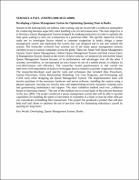| dc.description.abstract | SEMAKULA PAUL JOSEPH (2008-M132-20009)
Developing a Queue Management System for Optimising Queuing Time in Banks
Queues in the banking halls are tedious, time wasting, and do not provide a conducive atmosphere for conducting business especially when handling a lot of cash transactions. The main objective is to develop a Queue Management System designed for banking institutions in order to optimise the time spent waiting to carry out a transaction at a particular teller. The specific objectives of this study are: to investigate factors related to customer congestion in banks, design a queue management system and implement the system that was designed and to test and validate the system. The researcher reviewed four systems out of the many queue management systems currently in use in various companies across the globe. These are: Smart Soft Queue Management System, Smart Queue Management, Onlinet Queue Management System and Intel visions Optic Q Management System. Based on the review of these systems, we instinctively selected the Smart Queue Management System because of its performance and advantages over all the other 3 systems, nevertheless, we incorporated an extra feature by use of a mobile phone, to enhance its cost-effectiveness and efficiency. The researcher issued questionnaires to and carried out interviews with respondents in banks to investigate factors related to customer congestion in banks. The researcher/developer used specific tools and techniques that included Data Flowcharts, System Flowcharts, Entity Relationship Modelling, Use Case Diagrams, and Prototyping and CASE tools while designing the Queue Management System. The implementation tasks will involve purchase of the necessary hardware and server software, installing the system using a phased approach, carrying out security tests and implementing security measures, training users and guaranteeing maintenance and support. The main validation method used was „validation based on functional checks‟. The aim of this method was to reveal faults in the relevant functions of the new QMS. The project produced a queue management system that will be able to provide capabilities for handling the speed of movement of customers in a bank so that the other officials can concentrate on handling their transactions. This project has produced a product that will also help staff and clients to optimise the use of precious time by eliminating redundancy caused by queuing for long hours.
Key Words: Developing, Queue Management System, Banks | en_US |


